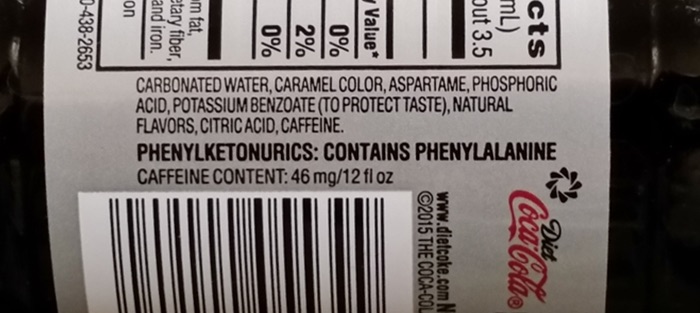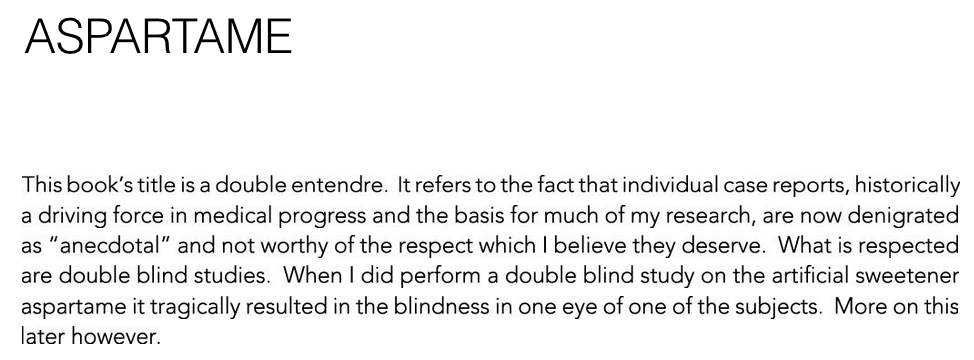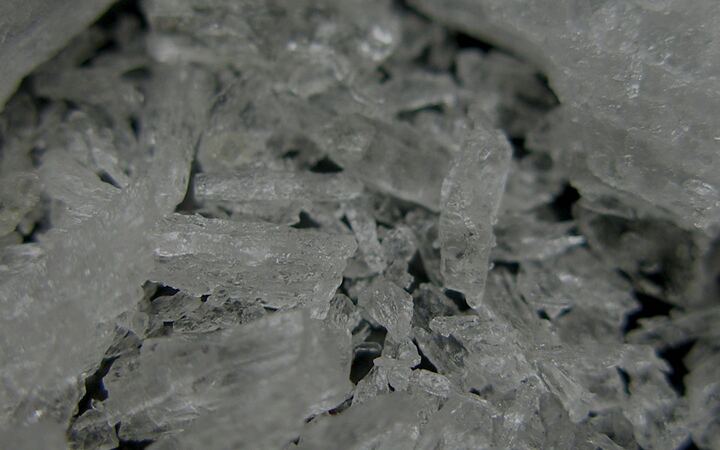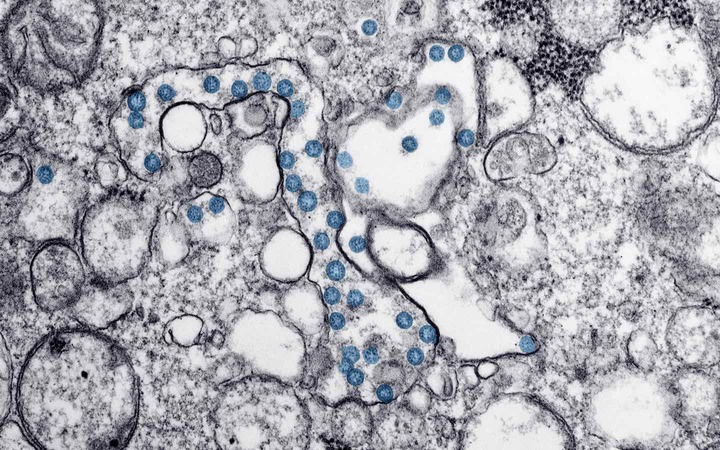Look, I get it. Diet Coke tastes sweet because it has aspartame in it. Aspartame is a weird synthetic molecule that’s 200 times sweeter than sucrose. Half of the world’s aspartame is made by Ajinomoto of Tokyo—the same company that first brought us MSG back in 1909.

If you look on Wikipedia, you’ll see that aspartame is a methyl ester of the aspartic acid phenylalanine dipeptide, which isn’t, like, comforting.
It’s normal to have a prior that aspartame might be bad for you. Certainly, that was my prior. Without looking at any evidence, any reasonable person would think like this:
| aspartame is… | odds |
|---|---|
| …good for you | very unlikely |
| …harmless | plausible |
| …bad for you | plausible |
This makes the decision theory pretty simple: Consuming aspartame has little upside, but substantial downside.
The thing is, we do have evidence. We have a lot of evidence. The FDA calls aspartame “one of the most exhaustively studied substances in the human food supply”.
The other thing is, the alternative to aspartame often isn’t no aspartame but rather sugar or corn syrup or even perhaps even alcohol.
I don’t want to convince anyone to consume aspartame. But if we’re choosing between aspartame and other risky things, we should evaluate the relative risks.
What happens to aspartame after it goes into your body
Let’s forget about safety for a second, and just look at the causal chain. Say you drink a Diet Coke. What happens next?
Fact 1: Aspartame is quickly broken down in the gut.
After you drink a Diet Coke, the aspartame goes to your guts. After that, it’s very quickly broken down into 50% phenylalanine, 40% aspartic acid, and 10% methanol. For example, a can of Diet Coke contains 184 mg of aspartame. This becomes:
- 92 mg of phenylalanine
- 73.6 mg aspartic acid
- 18.4 mg methanol
This happens quickly and completely. No aspartame ever enters your bloodstream. The rest of your body only ever sees these three other chemicals. (click here or on any paragraph with a triangle for more details)
The European Food Safety Authority Report (EFSA) report: Scientific Opinion on the re-evaluation of aspartame as a food additive gives this figure (slightly modified):
The same report gives this discussion:
Fact 2: Phenylalanine is a standard amino acid you consume all the time.
We recently talked about phenylalanine. It is an essential amino acid. If you didn’t consume any of it then when your body tried to make certain proteins those proteins would get truncated, and then they wouldn’t do what they are supposed to do, and then you would die.
Fortunately, that’s almost impossible. From 2% to 5% of all protein in food is phenylalanine. The recommended dietary allowance for a 70 kg (154 lb) person is at least 2130 mg. Meat-eating men in the UK average 3500 mg per day, while vegetarians and vegans get slightly less.
Here are the amounts of phenylalanine in a few foods:
| potato | 170 mg |
| large egg | 340 mg |
| 8 oz (235 ml) glass of milk | 430 mg |
| 400g box of tofu | 3300 mg |
The 92 mg of phenylalanine you get from a Diet Coke is much less than what virtually everyone already gets from other sources.
RDA guidelines are here. For adults, the recommendation is at least 33 m/kg of phenylalanine (or tyrosine, a metabolite of phenylalanine). For a 70 kg (154 lb) person, that would be 2130 mg.
Around 1 in 12,000 babies is born with phenylketonuria, a serious genetic disorder that results in low levels of phenylalanine hydroxylase, making it difficult to metabolize phenylalanine. People with phenylketonuria need to carefully monitor their consumption of phenylalanine (from all sources). This is why there’s this scary ALL-BOLD WARNING.

If you had phenylketonuria you would know it already.
Fact 3: Aspartic acid is a standard amino acid you consume all the time.
Here’s a chart from Wikimedia with our friends circled:

Aspartic acid is not essential in humans, meaning that if you don’t eat it, your body can make it (usually from oxaloacetic acid). But that’s not likely, since almost everything with protein has aspartic acid including meat, grains, dairy, vegetables, and eggs. Men in the UK average 6600 mg of aspartic acid per day.
The 74 mg of aspartic acid you get from a Diet Coke is two orders of magnitude less than what most people get already.
Here’s Schmidt et al. (2015) again:
Fact 4: Methanol is a simple alcohol you consume all the time.
Methanol (CH₃OH) is the simplest alcohol molecule. It’s in lots of food. Here are some foods with larger average amounts.
| food | mg/kg methanol | typical serving | methanol |
|---|---|---|---|
| wine | 115.0 | 150 ml glass | 17 mg |
| tomatoes | 281.4 | medium 125g tomato | 35 mg |
| citrus fruit | 106.5 | medium 140g orange | 15 mg |
This vastly underestimates how much methanol you get. In land plants, the primary component of cells walls is pectin. Once in the body, pectin degrades into methanol. Here are some estimates of the indirect increase in methanol various fruits and vegetables cause in this way.
| food | mg/kg methanol | typical serving | methanol |
|---|---|---|---|
| root vegetables | 774 | medium 200 g potato | 155 mg |
| apples | 508.5 | medium 170 g apple | 132 mg |
| oranges | 531 | medium 140g orange | 74 mg |
| bananas | 657 | 120g without skin | 79 mg |
| avocados | 486 | 100g (flesh only) | 59 mg |
You get the idea. We eat things that contain methanol or metabolize into methanol all the time. It’s estimated that most people get between 130 and 1030 mg of methanol from food per day, much more than the 18 mg in a Diet Coke.
Now isn’t methanol toxic? Sure, if you consume enough of it. The LD₅₀ in rats is around 5600 mg/kg, as compared to 7300 mg/kg for good-old ethanol.
One "conspiracy theory" you hear about aspartame is that it becomes formaldehyde once it's in the body. This is absolutely true: When metabolizing methanol, formaldehyde is created. But small amounts of formaldehyde are completely normal. The half-life of formaldehyde in human blood is around 1 minute, meaning it disappears almost immediately. You get more formaldehyde (via methanol) by eating an apple than by drinking a Diet Coke. Formaldehyde itself is also present in lots of foods, like meat, seafood, fruits, vegetables, and coffee.
The EFSA report:
Also the ESFA report:
Also Dhareshwar and Stella (2008):
The EFSA report again:
Fact 5: This doesn’t prove aspartame is safe.
To summarize the above:
- Aspartame is quickly broken down in the gut into phenylalanine, aspartic acid, and methanol. Aspartame itself never enters your bloodstream or touches any other part of your body.
- Phenylalanine is normal.
- Aspartic acid is normal.
- Methanol is normal.
(Incidentally, this same logic does not apply to other artificial sweeteners which mostly aren’t broken down at all.)
While informative, this does not prove aspartame is safe. Biology is crazy. But it should inform our priors. Speaking for myself, my previous model was that consuming aspartame would result in a crazy unknown synthetic chemical circulating around my body and doing god-knows-what. My updated model is that consuming aspartame results in slightly larger amounts of some totally normal chemicals.
This is reassuring. But even if they’re normal, could these chemicals still cause harm? Sure. Fortunately for us, aspartame was invented a long time ago, so we have lots of evidence.
The scientific consensus
How to think about this situation
Aspartame was first made in 1965 and was approved by the FDA in 1981. In the decades since, there have been hundreds of studies.
Given so many studies, focusing on individual papers is a mistake. With enough monkeys pounding away at enough typewriters scientists pounding away at enough science, lots of weirdness is expected.
The right strategy is to look at the entire pool of evidence. Some tiny number of people have the time and expertise to comb through the entire literature and synthesize everything. For the rest of us, the only sane thing is to read other people who have done that synthesis.
The US Food and Drug Administration (FDA)
In typical US government fashion, the FDA doesn’t go to great lengths to explain its reasoning to the public. The best you can find is this rather lame page:
The history of aspartame and the FDA is contentious and sort of infuriating. For the scientific question of “is aspartame safe?” the main thing to know is that the FDA approved it a long time ago, and continues to stand by those decisions.
But it must be said that the history and public communication of the FDA on this issue is kind of a train wreck, and if I wanted to optimize it to serve as conspiracy theory fuel, I could scarcely do any better. The FDA says it continues to monitor new studies and remains confident aspartame is safe. So why doesn't it explain its reasoning to a skeptical public? The newest document the FDA can point people to is from 26 years ago. When a concerned citizen writes in, the FDA does things like respond 12 years later, while acting like that's perfectly normal.
The FDA first approved aspartame for dry foods in 1974. However, there was a lot of controversy about the studies performed by G.D. Searle, the company that discovered aspartame in 1965 (and that Donald Rumsfeld would become CEO of in 1977). The FDA commissioner agreed with these criticisms and placed a stay on aspartame’s approval.
After more debate, the FDA finally approved aspartame in 1981 in a 26-page report with this summary:
In 1983 the FDA added approval for carbonated beverages. The report is mostly boring but this part is fun:
There was controversy about US Attorney General Samuel Skinner who was involved in the case and then went on to take a job at a law firm that Searle used. This led Senator Metzenbaum to request an investigation by the Government Accountability Office (GAO). They reported in 1987 that the process had been followed correctly. They also got responses from 69 researchers, 43 of whom worked in aspartame research.

Finally in 1996, the FDA approved aspartame as a “general sweetener”.
Also in 1996, Roger Walton, a psychiatrist at Northeastern Ohio Universities College of Medicine, wrote a survey that claimed that 74 out of 74 industry-funded studies confirmed aspartame’s safety whereas 84 out of 91 independent studies identified health concerns. Walton went appeared in a 60 Minutes special on aspartame. It later turned out that Walton had missed at least 50 peer-reviewed studies and most of the independent “studies” he did cite were really just letters to the editor or similar, many weren’t negative, and some didn’t involve aspartame at all.
For example, Walton cites Wurtman (1985). This appeared in the Lancet, which is a very good journal. But it’s just a 5-paragraph letter to the editor that points out that aspartame creates phenylalanine without other amino acids, which might do something in the brain—an idea we’ve looked at recently—and gives some anecdotes about people getting seizures. Real studies do not confirm these anecdotes. Wurtman himself did a real study in 1998 that found “Large daily doses of aspartame had no effect on neuropsychologic, neurophysiologic, or behavioral functioning in healthy young adults”. But the Walton report remains discussed to this day. Just a few months ago, Walton published a book called “Double Blind”. I’ll let you judge the credibility for yourself:

Since 1996, the FDA doesn’t appear to have published any systematic argument that the current science supports the idea that aspartame is safe. If you look really hard, you can find a few places where the FDA has recently been forced to justify the idea that aspartame is safe. For example, a concerned citizen wrote to the FDA in 2002 and sent this response in 2014:
The European Food Safety Authority (EFSA)
Fortunately, other countries exist. The EFSA has a nice page that summarizes things this way:
The bottom of the page has a timeline that clearly presents all past activities, and clearly links to all ongoing studies and reports. (The fact that I’m impressed by such basic things drives home just how low the FDA sets the bar.)
There’s also an extremely nice-263 page risk assessment. This document is the single best (most clear, credible, thorough, and up-to-date) source of information I could find on the safety of aspartame. Here are some quotes from the summary:
there was no epidemiological evidence for possible associations of aspartame with various cancers in the human population.
The Panel considered the database on the genotoxicity of methanol and concluded that the data set was limited but that the available reliable in vitro and in vivo data did not indicate a genotoxic potential for methanol.
the calculated [No Observed Adverse Effect Level]s for methanol by oral exposure are 140 and 515-fold higher than the maximum amount of methanol that could be released when aspartame is consumed at the [Acceptable Daily Intake].
the data on reproductive and developmental toxicity did not suggest that there was a risk from methanol derived from aspartame at the current exposure estimates or at the [Acceptable Daily Intake] of 40 mg/kg bw/day.
based on recent measurements of basal levels of formaldehyde in blood and on the modelling of its biological turnover and steady state concentration in cells, formaldehyde formed from aspartame-derived methanol was not of safety concern at the current exposure estimates or at the ADI of 40 mg/kg bw/day.
It ends this way:
Health Canada
Canada is one of the clearer communicators:
Here are their conclusions in a handy table:
| Allegation | Conclusion |
|---|---|
| The methanol in aspartame is toxic and is linked to numerous health problems including lupus and blindness, and also mimics multiple sclerosis | Not supported |
| Aspartame is especially dangerous for person with diabetes | Not supported |
| Aspartame causes cancer and brain tumours | Not supported |
| Aspartame causes seizures | Not supported |
| Aspartame causes allergic reactions | Not supported |
New Zealand Food Safety Authority
From an archived page:
Joint Expert Committee on Food Additives (JECFA)
The UN and WHO “jointly” run the JECFA. The only public reports I can find from them are really old, like 1980. For what it’s worth, this was the conclusion:
As far as I can tell, this 1981 update is the last word on aspartame from the JECFA. However, the JECFA currently has aspartame on the priority list of substances proposed for evaluation, as requested by Columbia, Costa Rica, and—somehow—the United States of America. (Update: A summary of this report is now out. I’ve written about it here.)
The Academy of Nutrition and Dietetics
This is a seemingly respectable organization of more than 100 thousand food and nutrition professionals, albeit one funded by food industry lobbying groups. Their position report states:
Literature reviews
Again, I don’t think it’s productive to look at individual papers. But we can look at reviews of all the evidence.
Here, some judgment is required. If I type “review aspartame safety” into Google scholar, many of the papers that come up have several of the following features:
- Paper is published in an obscure journal
- Authors are from obscure institutions
- Paper only engages with a tiny slice of the literature
- Paper just “doesn’t look right” (e.g. has a serious grammatical error in the title)
For full transparency, here are the papers I found less credible for the above reasons, given as hopefully-offense-minimizing numbers: 1 2 3 4 5 6 7 8. Note that many of these do suggest health concerns with aspartame, but I am discounting their conclusions because I don’t think they are credible. If you don’t trust me, you should look at those papers yourself. I have linked (here or below) everything I found that was published after the year 2000 and claimed to be a review of aspartame.
Butchko et al. Aspartame: Review of Safety. Regulatory Toxicology and Pharmacology, 2002.
Our first is a 93-page monster from a team of 24 scientists (three of whom, note, are employed by The NutraSweet Company). As I write this, it’s been cited 344 times. In their summary, you can feel the frustration:
Here’s a table from this paper:
This is helpful to put things in perspective. If you drink a Diet Coke, you get 2.6 mg/kg of aspartame, assuming you weight 70 kg. That’s around 20 times less than the government recommended limits. It’s also around 1000 times less than doses that do not show harms in animals.
Magnuson et al. Aspartame: A Safety Evaluation Based on Current Use Levels, Regulations, and Toxicological and Epidemiological Studies. Critical Reviews in Toxicology, 2007.
This is a 99-page paper that’s been cited 430 times so far. The conclusions are kind of feisty.
Note that this study was funded by Ajinomoto via some kind of blind-trust arrangement.
The paper describes it this way:
I still mostly trust this paper, but we all know how these things can go.
Rogers et al. Does low-energy sweetener consumption affect energy intake and body weight? A systematic review, including meta-analyses, of the evidence from human and animal studies. International Journal of Obesity, 2016.
This paper has 320 citations and 11 authors (four of whom—sigh—have gotten grants from or worked at sweetener companies). It focuses on metabolism and weight. Here is their conclusion, where LES = Low-Energy Sweeteners, EI = Energy Intake, and BW = Body Weight.
Other reviews
There are many other reviews that seem scientifically solid, but aren’t as comprehensive as those above. Here’s a representative snippet from each:
| paper | snippet |
|---|---|
| Kroger et al. (2006) | “within the range of variation caused by day-to-day differences in food intake and are clearly not harmful” |
| Marinovich et al. (2009) | “not consistently related to vascular events and preterm deliveries.” |
| Mallikarjun and Sieburth (2013) | “suggest that [aspartame] consumption has no significant carcinogenic effect in rodents.” |
| Santos et al. (2018) | “no found deleterious effects associated with aspartame consumption on variables studied” |
| Haighton et al. (2018) | “a conclusion that aspartame is not carcinogenic is supported” |
| Haighton et al. (2019) | “do not support that [low calories sweeteners and] aspartame, are associated with an increased risk of cancer in humans.” |
| McGlynn et al. (2022) | “small improvements in body weight and cardiometabolic risk factors without evidence of harm” |
Why write this?
I write all this with some trepidation, as my previous mentions of aspartame caused a surprising amount of rancor.
But whatever, I’ll die on this hill: After aspartame is consumed, it immediately breaks down into three naturally occurring chemicals. Even large amounts of aspartame cause smaller fluctuations in those chemicals than normal food. The current science says that the health impact of aspartame is essentially zero. Every credible body that has studied this question has reached the same conclusion.
Is it possible that some harms have been missed? Of course! That’s how science works: Evidence accumulates slowly. It never becomes a sure thing, we just eventually decide it’s sure enough and move on with our lives.
So why are we still talking about aspartame? Why worry about it rather than, say, sugar or alcohol? I know many people who avoid diet soda but drink sugar-sweetened soda or large amounts of alcohol. That’s choosing a known harm over something that appears harmless.
Or, why not worry about:
- Lightning
- Q-tips
- Fireplaces
- Bathtubs
- Generators
- Lawn mowers
- Umbrellas
- Cruise ships
- Air in subways
- Blood clots in planes
- Cosmic rays in planes
- Charred meat
- Anticholinergics
- Cocoa
- Perfluorooctanoic acid
- Helicobacter pylori
All of these present some real danger but mostly no one cares.
To me, most skepticism of aspartame looks like an isolated demand for rigor—an impossibly high standard of evidence that isn’t applied to other things. We all have finite bandwidth for things to worry about, and the evidence places aspartame very low on the list of sensible worries.
Many of the same people who claim aspartame is risky exhort to Follow the Science in other domains. I wonder: What evidence would be convincing proof of aspartame’s safety, but doesn’t already exist? Is it even possible? If not, then OK! But if you only follow the science when the conclusions are intuitive, it’s not science that chooses your destination.

































































